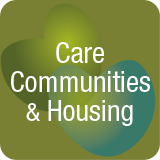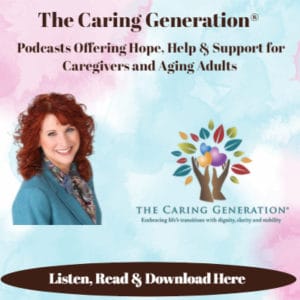Culture Change and Person Centered Care
 Culture change and person-centered care result when healthcare workers on the front lines are valued and supported by organizations. Despite significant national efforts since the 1980s, to improve quality of care, quality of life remains sub-standard for many nursing homes and assisted living residents.
Culture change and person-centered care result when healthcare workers on the front lines are valued and supported by organizations. Despite significant national efforts since the 1980s, to improve quality of care, quality of life remains sub-standard for many nursing homes and assisted living residents.
The culture change and person-centered care movements seek to improve residents’ quality of life and care by focusing on deinstitutionalization and individualized care.
Research lists six domains around which culture change efforts are focused: a) resident direction, b) home environment, c) close relationships, d) staff empowerment, e) collaborative decision making, and f) measurement-based quality improvement.1
Several models of culture change exist. These include the Wellspring Model, the Eden Alternative, and the Green House Model. Many communities tout progress in changing physical environments to appear more home-like, supporting the idea of culture change, by including common areas, plants, and animals in order to attract potential residents and caregiving families.
Other communities focus on deficiency-free surveys and Minimum Data Set (MDS) quality indicators to support person-centered care.
While a visually pleasing environment and quality measures support culture change and person-centered care, focus and dedication to the individual care of the person may be missing from this recipe for communities focusing mainly on environment and quality indicators.
Many communities fail to address the root cause of the failure of person-centered care which includes high staff turnover, a lack of consistent and well-trained workers, and poor coordination across care teams.
Admittedly, in spite of nearly 30 years’ focus on culture change and person-centered care, there remains no common success framework for implementation or a framework documenting best practices in all categories. The Advancing Excellence in America’s Nursing Homes Campaign promotes culture change that bridges medical and resident quality and includes: avoiding restraints, pain prevention and reduction, prevention and treatment of pressure ulcers, resident and family satisfaction, advance care planning including personal preferences, minimizing staff turnover, consistent certified nursing assignment, and staff satisfaction. 2 Staff education and training is a key component of achieving these goals.
Presently, “direct care jobs have few skill requirements, minimal selectivity in hiring, cursory initial orientation and on-the-job training, low wages, and benefits and supervision focused on completion of defined tasks.”3 This description is accurate of direct care workers in skilled and non-skilled home care, those working in assisted living communities, nursing homes, and in hospitals, and is fueled by the idea of a “low road” enterprise.
The term “low road” enterprise was initially coined by the manufacturing industry where the focus was on jobs geared to specific tasks requiring narrow skills with no discretion over the task and relatively low wages. In a sense, a worker was hired to place a widget into a piece of machinery and repeated this task throughout the day.
How many of you remember the television series, I Love Lucy and the episode of Lucy and Ethel working on the assembly line in a candy factory expected to wrap chocolates?
If you remember watching I Love Lucy’s Famous Chocolate Scene this is a funny, but simple example of a low-road enterprise. Today, fast food restaurants like McDonald’s and Burger King may be considered low-road enterprises even though wages are now more competitive with other jobs.
While healthcare may be considered a low-road enterprise, the differentiation is that most low-road enterprise positions tend to be unsatisfying. For many individuals who work in healthcare and have a desire to serve, the work is extremely satisfying.
This differentiation presents an opportunity for healthcare companies and employers who are willing to invest in employee education and training to focus on culture change and person-centered care and to succeed.
The opportunity to successfully implement culture change and person-centered care might be more available to employers with private pay clients, than to employers limited by the payer source of Medicare or Medicaid who may be marginally profitable. Although some research indicates that non-profit organizations have better outcomes than organizations that are profit motivated.
For person-centered care to succeed, companies must change from low-road enterprises to high-road enterprises focusing on creating high-performance work teams and systems. Creating high-performance work teams and systems may be more easily achieved by national companies like Brookdale Senior Living or Sunrise Senior Living.
Both are independent, assisted living, memory care, and in some cases nursing home providers, with layers of upper management, systems, and procedures already in place. However, for consumers of health care who seek alternatives, a national company may not always offer the right fit.
Becoming more prevalent in the industry are care communities described as personal care or family homes, serving 6 to 20 residents. Personal care homes offer a true home-like environment; many are located in residential neighborhoods.
Similar to the challenge of implementing person-centered care in communities where the payer source is Medicare or Medicaid and profits may be marginal, is the challenge that the healthcare industry lacks consistent standards of required training and continuing education, requiring financial investment, that supports the idea of person-centered care.
Until the community at large, both government and consumer, value higher care standards, success in implementing personal care may continue to linger as it has done over the past 30 years.
To give an example, in the state of Colorado, any individual seeking to open and manage an assisted living community may do so by completing a 30-hour course with no future requirement of training or education or prior experience in aging or healthcare. Operating an assisted living community, at least in Colorado, has a low barrier to entry which in some cases leads to significant issues of resident neglect and poor care.
The state of Washington because of an initiative led by Michael Berens of the Seattle Times, called Selling Seniors, has implemented legislation (State of Washington House Bill 1277 Long Term Care Settings) to more aggressively promoting protections for vulnerable adults living in licensed and certified long term care settings including minimum qualifications for education and training.
Few states have implemented similar legislation due to the controversy of requiring long-term care communities to increase standards in an industry where costs are high and profits low, thus continuing to place vulnerable older adults at risk.
An educated and trained workforce is the cornerstone of successfully implementing person-centered care. Four of the six domains of culture change identified above relate to employee skills and abilities.
In my opinion, the success of person-centered care lies in the ability of employers to screen, recruit, train, manage teams, and retain and promote employees. That being said employers operating care communities must have the level of training and education to train staff and profits to support training.
Complicating factors relating to the background of direct care workers include an increasingly diverse workforce. Many direct care workers experience language barriers because English is their second language.
This challenge contributes to difficulties in communication, learning, and working with older adults, many of whom are from earlier generations and possess racial bias. Communication and language barriers represent risks in other areas including misinterpretation of chart data and medical orders that place patients and residents at risk of poor medical care if directions are not clearly understood.
Concepts for supporting the implementation of person-centered care in all areas of healthcare must focus on a skills agenda that includes:
- Training for management supporting leadership and employee development
- All employee training in the areas of teamwork, empowerment, collaborative decision making and initiative
- Employee screening and recruitment processes
- Job training supporting practical skills and technical requirements
- Language and communication skills for all employees
- “Soft” skills to support an understanding of resident direction, close relationships with residents and family members, and addressing concerns in a proactive (rather than reactive) manner
It is widely recognized in the industry, that most companies lack budgets for training and education. Websites like The Caring Generation provide options for free education for professional caregivers.
For those who desire to become industry leaders by embracing person-centered care, training budgets must become part of the operating budget.
Companies will continue to experience the “chicken and the egg” dilemma by expressing concern that they must be able to charge more for care in order to have funds for employee training programs.
My response is that until providers are able to offer value, more value than competitors, consumers seeking healthcare services will have no reason to pay more for your services than a competitor also touting that they offer “superior service”.
Because of the increase in the aging population, the number of non-skilled and skilled home care providers, independent and assisted living communities, memory care, and nursing homes will continue to increase at a rapid pace.
While companies will be able to retain clients and fill beds because of the sheer number of consumers needing services, the industry will continue to struggle and provide less than optimal care until the government and the healthcare industry embraces the value of employee investment in training that results in true culture change and person-centered care.
Looking to build your caregiving skills? Check out Pamela’s complimentary online caregiver program.
References:
1 Shier, V. MPA, et. al. (2014) What Does the Evidence Really Say About Culture Change in Nursing Homes? The Gerontologist, Vol. 54, No 31, S6-S16, doi:10.1093/geront/gnt147
2. Zimmerman, et. al. (2014) Transforming Nursing Home Culture: Evidence for Practice and Policy. The Gerontologist, Vol. 54, No. 31, S1-S5, doi:10.1093/geront/gnt161
3 Bishop, Christine E. Ph.D. (2014) High Performance Workplace: Practices in Nursing Homes: An Economic Perspective. The Gerontologist, Vol. 54, No 31, S46-52, doi 10.1093/gerontgnt163
4 Allan, Cameron, et. al. Visual Learning Assessment in Employment Relations: Structure and Meaning. Griffith Business School Griffith University. 21st Century Work – High Road or Low Road? Proceedings of the 20th AIRAANZ Conference, Volume 1
© 2014, 2022 Pamela D. Wilson, All Rights Reserved.
Return to Care Communities and Housing PageReturn to All Category Page



